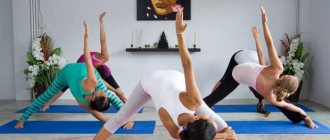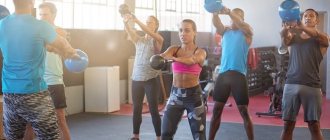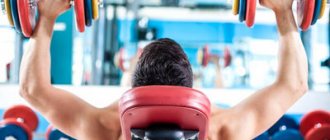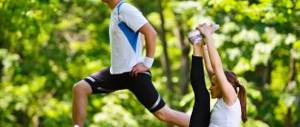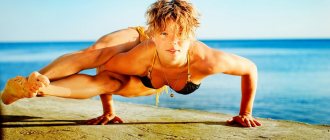Yoga for beginners at home
can begin with a technically uncomplicated, but complete and strong complex
“Soft entrance to yoga”
.
This set of asanas is designed to restore physical fitness, as well as gently and deeply work the body through easy-to-understand yoga asanas. It harmoniously combines flexibility exercises, stretching and strength training. Source - Esoterics.
Living Knowledge Clear instructions for performing asanas
, precise timing of the lesson and detailed drawings for printing will allow beginners to begin independent yoga classes at home with a full understanding of what is happening. This yoga complex, consisting of 20 exercises, will gently introduce you to yoga if you are a beginner, or will help you recover after a break in classes.
Be prepared for that
that despite its apparent simplicity, this yoga complex will not be easy for you the first time, so you will have room to develop and something to strive for.
So, a gentle introduction to yoga for beginners at home...
Basics
Everything, even basic yoga asanas for beginners, must be performed on a special mat, and it doesn’t matter whether you practice at home or in a class. It is worth noting that even the most basic exercises should be performed in comfortable, easily stretchable clothing that will not impede your movements. If your activity consists primarily of slow, gentle exercise, opt for warmer clothing (such as sweatpants and a long-sleeved tank top), but if your workout will be at a more vigorous pace, shorts and a T-shirt or crop top will fit perfectly. Yoga trainers often say, “Leave your ego at the door,” so you shouldn't be embarrassed by what you wear in your classes. Wear what you really feel comfortable doing.
Some activities will require the use of additional props such as straps, blocks, special pillows, blankets and chairs. For your first lessons, there is no need to buy them all, especially if you are a beginner.
If you are going to practice yoga in a studio, then the trainers will provide you with everything you need for the exercises. However, if you study at home, watching online lessons or a tutorial, then you will certainly need a mat, and it is also worth finding out whether these classes require any additional props. If necessary, there are many ways to replace specialized yoga equipment with some improvised items. For example, you can easily replace special belts with a rope or a regular belt. If the exercise involves the use of a pillow, then you can make such a pillow yourself.
If you decide to buy something for your classes, then first of all pay attention to a yoga mat. Typically, yoga studios provide mats for their classes, however, often such mats are not of very high quality, and you may be more comfortable practicing on the mat that you have chosen for yourself. Yoga mats come in a variety of shapes and sizes, and they also vary in the material they are made from. Before choosing a mat, you should learn more about them (for example, by reading relevant articles on the Internet), especially if you want to purchase something made from non-toxic materials and that will provide support for your ligaments and joints.
Is yoga right for you?
Anyone can practice yoga, regardless of age, weight, place of work, religion, etc. Yoga is not some kind of exclusive practice for a select few. Yes, it is quite possible that due to injuries or damage you have suffered, you cannot do some kind of exercise that requires specific poses or certain breathing techniques, but an experienced instructor will always be able to find safe alternative exercises for you. If you're over 55, out of shape, or don't have much flexibility, start with slower, gentler workouts and over time you can progress to something more challenging. Never endure pain. Some discomfort is acceptable, but body pain means you need to stop doing a particular exercise.
If you want to improve your flexibility and mobility, try stretching exercises.
Kundalini yoga exercises
Halasana allows you to maintain flexibility and change the flow of energy if it is stagnant.
- Lie on the floor, arms along your body and resting your palms on the floor, raise your legs behind your head
- Breathe in this position, imagining how with each exhalation you are clearing yourself of negativity
- Holding time is at least a minute
Surya Namaskar opens the heart chakra and helps get rid of grievances.
- As you inhale, raise your arms up
- We move our head and arms back. We bend the body
- We try to make every movement smoothly
- As you inhale, lean forward again
Paschimottanasana is a pose that enhances the fire energy in the abdomen and burns excess fat in this area.
- Sit on the floor and stretch your legs forward
- The body bends forward and clasps the feet with our hands.
- We put our heads on our knees and freeze
- Breathe deeply and calmly
Advantages
Exercise has many benefits. Yoga for beginners at home will help you:
- improve and maintain muscle tone, ligament flexibility, joint mobility and generally contribute to the overall health of organs;
- keep your mind clean and clear;
- sleep better;
- improve the functioning of your body parts and prevent injury when playing sports;
- speed up recovery after training;
- prevent diseases such as diabetes, cardiovascular and autoimmune diseases;
- mitigate the negative impact of the environment;
- improve your mood and overall well-being.
Yoga is a practice that has a beneficial effect on both your physical fitness (improves overall body tone and endurance, corrects posture, develops your strength and flexibility) and spiritual well-being (helps relieve stress, relax, feel healthy, and also energizes you).
The best way to find out if yoga is right for you is to simply try it. First of all, visit several different studios and choose the one you like best. You can perform a yoga complex for beginners at home, but it is better not to neglect the professional advice of an instructor: he will answer all your questions, select the most suitable asanas for you and give you the necessary recommendations before you start your first lesson. If you have any injuries or injuries, talk to your doctor before going to the yoga studio.
Second stage with breath holding
The second stage of breathing will be similar to the first. But, breath holding will be added to this cycle.
- Inhale through the left nostril (the right one is closed). As in the previous exercise, inhale in four counts.
- Close both nostrils and hold your breath. We count to 16 (1, 2, 3, ... 16). Beginners can shorten this interval to 8 counts.
- Open the right nostril and exhale for 8 counts, as in the first exercise.
- After exhaling, inhale through the right nostril and repeat all previous steps. You need to do 5 such cycles.
Preparing for the first lesson
Some rules are common to all studios: don't be late for class, don't wear perfume, and don't interrupt the instructor. Questions are always welcome, but it is best to ask them before or after the training.
Each instructor has his own approach to teaching. Some trainers focus more on the students' postures, while others focus on meditation. Some people read mantras, others don’t. Some correct their students by correcting their movements, and some do not think this is necessary. Your workouts may vary from class to class, even if it's just one type of yoga. Therefore, if you suddenly did not like your first lesson, then do not immediately quit your yoga practice. You can always find an instructor who is right for you.
A yoga class is a place designed to make you feel as comfortable and free as possible. This is a place where no one will judge you. Don't worry if you can't keep up with everyone else. Exercise at your own pace, taking safety precautions first and not risking your health. In order to take part in the class, you don’t even need to know the names of all the asanas, because each instructor explains in detail and clearly how to do this or that exercise correctly, and will also give you the necessary tips and recommendations for their implementation.
Yoga and weight loss
Yoga certainly doesn't compare to a good cardio workout, so it's not that effective for weight loss. However, yoga is a great full-body workout that gets you working hard, sweating, and in some cases can even leave you feeling pretty exhausted. The whole point of yoga is that, through its challenging physical exercises, it tones your body and improves your overall health and can help you get rid of back pain. Yoga classes will help you develop flexibility, familiarize you with your body, and teach you how to truly relax. You can also try an asana complex for the buttocks to increase the tone and elasticity of the muscles on the butt.
Kundalini yoga for beginners
This direction of yoga differs from the classical one in the following technical features:
- Eyes must be closed
- Full concentration of consciousness
- Legs crossed in lotus position
- Pronunciation of mantras
- Be sure to have a straight spine
- Different breathing techniques
With all this, the main focus of kundalini is the movement of vital energy Qi through the chakras. Chakras are points of concentration of energy located on our body in a certain sequence.
Types of Yoga
If you have never practiced yoga before, then first of all turn your attention to hatha yoga. By doing this type of yoga, you will pay attention specifically to physical poses (asanas), and focus less on mantras, pranayama or meditation. Hatha yoga movements are performed at a fairly slow pace, which allows you to concentrate on the correct technique for performing the exercises.
If you are over 55 years old, your trainer will be able to select more gentle exercises for you. If you don't think you're flexible enough, don't worry! Practicing yoga will benefit you just as much as everyone else, it just takes a little longer. You can try yin yoga, in which you need to hold poses for much longer, and the exercises are more aimed at meditation. If you are already quite prepared and want to try something more difficult, then take a power yoga class.
Yoga for pregnant women
If you are waiting for a small miracle, then not all exercises may be suitable for you. Here it is better to choose special exercises for pregnant women or consult a professional to select personal Asanas.
Be mindful and listen to your body. If something makes you uncomfortable, don't do it as hard as you can. Leave the exercises and come back to it tomorrow. Your muscles will become more elastic day by day, and with each new exercise the exercises will become easier.
What to expect from studio classes
Yoga classes last from 45 minutes to 2 hours, and group sizes can range from 2 to 100 students, depending on the size of the room in which the classes are held.
The rules of most yoga studios do not prohibit you from coming to practice at any time, which is convenient if you have an unpredictable daily schedule. However, some studios still require you to register before classes begin and pay a certain fee for a certain period of time.
If the number of students in the group is not very large, then your instructor can give you individual advice and adapt the asana personally to your capabilities. If you have any difficulty performing a particular asana, your trainer can show you an alternative pose. But if the group size exceeds 20 students, then, of course, it will be more difficult for the instructor to give you personal attention. An experienced instructor can also take advantage of other exercises you do in a group.
Basic Science of Yogic Breathing
Breath control during yoga is a prerequisite for successful practice. Without it, it is impossible to perform the exercises correctly.
The main condition for performing breathing exercises in yoga is awareness. Ideally, you need to monitor each breathing cycle. At the same time, you need to breathe freely, without excessive effort or muscle tension.
When working with full breathing, inhalation should be done through the nose. At the same time, the body is kept straight.
How often should I do yoga?
By doing yoga 3 times a week or even more, you will soon notice significant changes that have occurred in you: increased flexibility and elasticity of the ligaments, increased joint mobility and sense of balance, you will learn to better cope with stress, sleep will return to normal and you will generally feel better. happier.
Of course, all this is relative, since we all differ both externally and internally. But regular yoga practice once or twice a week will help you maintain your physical fitness and emotional balance, and with continued practice, you will definitely notice an improvement in your overall health. The more time you devote to yoga, the more benefits it will bring you.
Where to start doing yoga at home
Before you start training, you should prepare. There are some important aspects to pay attention to.
Time. You shouldn’t just start with a three-hour lesson. You need to choose an individually suitable time, then you can increase it. 15, 30, 45, 60 or 90 minutes will do. It is recommended to do yoga every day. It is better to exercise for half an hour every day than 2 hours 2 times a week.
Cloth. Things should fit the body so that they do not hang over the face when performing some asanas. All-natural materials quickly fail. A mixture of synthetics and natural fibers or high-quality synthetic sportswear is recommended. For classes, purchase a special soft mat.
Environment. The study room must be ventilated. During the warm season, keep the window completely open. We need to get rid of all distractions. Turn off the phone, send the cat to another room, ask relatives or neighbors not to disturb you at this time.
Yoga as a worldview
Yoga is not a religion, cult or faith. Self-knowledge is at the core of yoga. The purpose of everything we do, be it asanas, meditation, mantras or breathing techniques (pranayama), is to create a connection between our body and our life experiences in some more meaningful way. For example, understanding how the effort expended and the result obtained require constant attention and concentration from us on a sensory level. Awareness of this is essential in our daily lives, along with meditation, stress management and the ability to relax. The ability to relax is a truly useful skill. Understanding how to move from one asana to another with minimal effort while maintaining even breathing and a calm mind is invaluable, especially in the realities of our constant busyness and workload.
The philosophy of yoga arose as a result of a strong desire to know oneself, to free ourselves physically and emotionally. Yoga is about much more than just doing certain physical poses. Through yoga, we can understand who we really are, what we want and why we are here. The more time you spend practicing yoga, the more likely you are to dig deeper within yourself and understand what shapes you as a person. Yoga helps free your mind from outdated patterns of worldview. It will make you feel more open and happy, and help you interact more fully with friends, family and the rest of the world.
We hope this article answered all your questions. We wish you the best and success in mastering asanas for beginners.
Yoga for Beginners: 10 Poses to Practice at Home
Relaxation pose
Image source: Takprosto.cc
Sit cross-legged and feel your spine relax and lengthen. You can stretch up slightly, leaning on your crossed legs. Sit in this position for a couple of minutes, breathing as deeply and evenly as possible. This will help you tune in to effective exercise and reduce stress levels.
Forward lean
Sit with your legs straight in front of you. Slowly reach to the tips of your toes. Focus on stretching as you exhale - at this moment the tendons and muscles of the legs will be more pliable for maximum stretching. Repeat this 5 times.
Child's Pose
Get on your knees, place them shoulder-width apart, keep your hands behind your body. Slowly lean forward, lower your head completely. Spend 3-4 minutes in such a relaxed position with breaks, breathe deeply and evenly, feel how your back is resting.
Place your right hand on your left knee. Fix your left arm behind your body and slowly turn to the left. Turn your head along with your body - look to the left. Breathe as deeply as possible! Slowly return to the starting position, feel how the oblique and lateral abdominal muscles and thigh muscles stretch. Repeat the same with your right leg.
Goddess pose
Lie on your back, bend your knees and touch the soles of your feet together. Keep your arms free at your sides. Breathe evenly, try to stretch the inner thigh muscles and feel it. Stay in this position as long as you feel comfortable - 2 minutes is enough.
Feet on the wall
Raise your legs straight and place them on the wall. Relax your torso and arms. Spend 3 minutes in this position, inhaling deeply. Try to drive away all unnecessary thoughts from yourself, feel how your tense back and legs are resting.
Free Wind Pose
Lie on your back, bend your knees, cross your ankles. Place your hands around your knees and hold them tightly. Feel the muscles in your hips and back stretch.
It may be difficult at first, but once you understand your body, doing the exercise will become incredibly pleasant: this pose relieves the spine of stress in just a minute! Don't forget to breathe deeply.
Pigeon pose
Get on all fours, keep your hands shoulder-width apart. Bring your left knee forward and place it between your hands. Take your right leg back and straighten. Bend your entire body forward, moving your center of gravity through your left knee. Stay in this position for a minute and change legs. This exercise relieves pain in the legs, swelling, and has a beneficial effect on the back muscles.
Awakening pose
Lie on your back, spread your arms wide to the sides. Bring your right knee to your chest. Then turn your entire torso to the left, while leaving your back straight. Stay in this position for about 3 minutes, repeat on the other side. This pose is very useful for anyone who often has back pain in the tailbone area.
Fish pose
Lie on your back. Place your hands under your hips. Slowly lift your chest up while throwing your head back. Breathe slowly. Lower yourself down just as slowly.
After such exercise, it’s as if you are born again! Muscle tension goes away, pain caused by fatigue and overwork disappears, the spine straightens. This relaxes the neck and improves blood circulation to the brain. There will be no trace of headaches and sleep problems!
